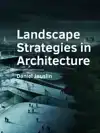- Engels
- Pockets
- kunst algemeen
- bouwkunst, archit.
- LANDSCAPE STRATEGIES IN ARCHITECTURE
JAUSLIN, DANIEL
LANDSCAPE STRATEGIES IN ARCHITECTURE
29,95incl BTW
Vertrouwd sinds 1927
Persoonlijke aandacht en advies
Vanaf 17,50 gratis verzenden NL & BE
Meer dan 150.000 artikelen online
Omschrijving LANDSCAPE STRATEGIES IN ARCHITECTURE
This thesis explores the ways in which landscape is relevant as a concept for designing architecture. Buildings that have been designed like landscapes have become a topic in contemporary architecture. The apparent distinction between architecture an
d landscape is questioned in exemplary theories and new designs.
The core of this thesis is three case studies of architectural designs that use landscape strategies. The analytical model for landscape architectural composition that Steenber
gen and Reh (2003) developed for the European gardens is applied as in drawing analysis of these building''s inner space composition. By distinguishing the landscape composition into a four layer model - ground form, spatial form, metaphorical form a
nd programmatic form - the analysis will alter the reading of three architectural projects.
Rem Koolhaas and OMA''s unbuilt Jussieu design for two university libraries in Paris of 1992 is visualised for the first time as it could have looked
if built. The Rolex Learning Centre at EPF Lausanne was declared ''landscape'' as architecture by its designers Japanese Architects Kazuyo Sejima and Ryue Nishizawa (SANAA) at the opening in 2010. The City of Culture of Galicia in Santiago de Compos
tela by American architect Peter Eisenman was designed in 1999 in a process of layering - similar to the layer model analysis of this thesis.
This thesis will interpret and compare the three architectural designs. It distinguishes design str
ategies, methods and landscape attitudes that are specific or commonly applied to the projects. Original drawing analysis and critique reveals unexplored potentials for landscape strategies in the architectural discipline.
d landscape is questioned in exemplary theories and new designs.
The core of this thesis is three case studies of architectural designs that use landscape strategies. The analytical model for landscape architectural composition that Steenber
gen and Reh (2003) developed for the European gardens is applied as in drawing analysis of these building''s inner space composition. By distinguishing the landscape composition into a four layer model - ground form, spatial form, metaphorical form a
nd programmatic form - the analysis will alter the reading of three architectural projects.
Rem Koolhaas and OMA''s unbuilt Jussieu design for two university libraries in Paris of 1992 is visualised for the first time as it could have looked
if built. The Rolex Learning Centre at EPF Lausanne was declared ''landscape'' as architecture by its designers Japanese Architects Kazuyo Sejima and Ryue Nishizawa (SANAA) at the opening in 2010. The City of Culture of Galicia in Santiago de Compos
tela by American architect Peter Eisenman was designed in 1999 in a process of layering - similar to the layer model analysis of this thesis.
This thesis will interpret and compare the three architectural designs. It distinguishes design str
ategies, methods and landscape attitudes that are specific or commonly applied to the projects. Original drawing analysis and critique reveals unexplored potentials for landscape strategies in the architectural discipline.
Specificaties
- MerkBK Books
- GroepKUNST ALGEMEEN (640)
- Barcode9789463662369
- LeverstatusActief
Reviews
0.0/5.0
Gemiddelde uit 0 reviews
Meest behulpzame reviews
Nog geen reviews geschreven


